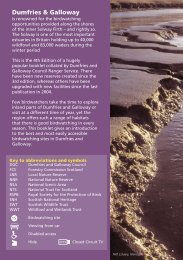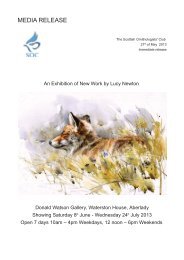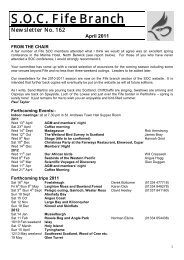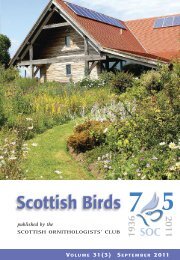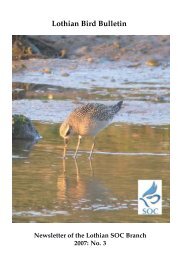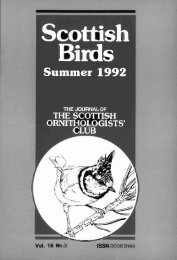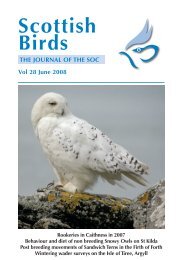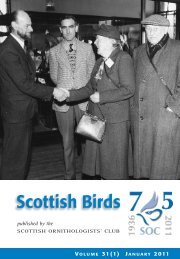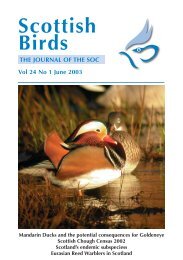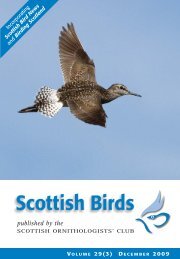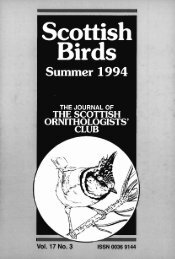V 14 No.4 - The Scottish Ornithologists' Club
V 14 No.4 - The Scottish Ornithologists' Club
V 14 No.4 - The Scottish Ornithologists' Club
You also want an ePaper? Increase the reach of your titles
YUMPU automatically turns print PDFs into web optimized ePapers that Google loves.
1987<br />
Dotterel numbers in Scotland 197<br />
Other methods might speed survey<br />
work and make it more reliable. One is to<br />
listen to calls at dawn and dusk, using a<br />
method developed for studying Red Grouse<br />
on large areas with low densities (Watson<br />
& O'Hare, 1979a). This proved valuable for<br />
spring counts of Golden Plover Pluvialis<br />
apricaria and several other bird species on<br />
Irish moorland (Watson & O'Hare, 1979b),<br />
and A.W. has found it equally effective for<br />
Ptarmigan, Golden Plover, and Dunlin<br />
Calidris a/pina on <strong>Scottish</strong> arctic-alpine<br />
ground. In May-early July in Scotland,<br />
members of each Dotterel pair without eggs<br />
or young call for up to 1 Y2 hours starting<br />
shortly after sunset, and again before<br />
sunrise, in light usually too poor to see<br />
them. <strong>The</strong>ir locations are obvious from the<br />
calls; they often call in flight, after calling<br />
on the ground. A second method that proved<br />
useful with Red Grouse was to play a taperecording<br />
of a cock's crowing, preferably<br />
with a stuffed cock as a decoy, whereupon<br />
the nearest cock often responded by flying<br />
close and calling. <strong>The</strong>se two methods might<br />
help show quickly whether Dotterel are present<br />
in spring.<br />
Although the Dotterel is undoubtedly<br />
much more abundant in Scotland than used<br />
to be thought, it is still an uncommon<br />
British bird. Some of the hills with high<br />
numbers are beside existing or planned ski<br />
developments (Thompson, 1986); others are<br />
near sites suggested for ski developments<br />
(Nethersole-Thompson & Watson, 1981). In<br />
view of these threats, and the still inadequate<br />
knowledge of Dotterel numbers and<br />
distribution in Britain, a sample survey as<br />
outlined above would be timely. One of our<br />
aims in presenting this paper was to help<br />
give any such survey a better base.<br />
Acknowledgements<br />
W. Bain, D. Batty, P. Batty, N. Buxton, B.<br />
Cosnette, R. Dennis, A. Dykes, N. Easterbee, P.<br />
Ewins, H. Galbraith, C. Geddes, P. Gladstone,<br />
D. Gowans, R. Heslop, R. Hewson, E. Jensen,<br />
B. Jones, D. Mardon, M. Marquiss, W. Mattingley,<br />
R. Mearns, G. Miller, M. Nicoll, S.<br />
Payne, D. Pierce, P. Pitkin, D. Pullan, S. Rae,<br />
G. Rebecca, J. Savory, B. Staines, A. Tewnion,<br />
A. Watson sen., J . Watson and V. Wynne<br />
Edwards extended our coverage of sightings. R.<br />
Dennis, H. Galbraith, B. Staines and D. Thompson<br />
made useful comments.<br />
References<br />
Bannerman, D.A. 1961. <strong>The</strong> Birds of the British<br />
Isles. Vol. 10. Edinburgh: Oliver & Boyd.<br />
Blackwood, G.G. 1920. Notes on the breeding<br />
habits of the dotterel Eudromias morinellus<br />
in Scotland. Scot. Nat. 98: 185-194.<br />
Cramp, S. (Chief Ed.) 1983. Handbook of the<br />
Birds of Europe, the Middle East and North<br />
Africa. Vol. Ill. Oxford: Oxford Univ. Press.<br />
Donaldson, J.C. 1984. Munro's Tables. Edinburgh:<br />
<strong>Scottish</strong> Mountaineering Trust.<br />
Gordon, S.P. 1915. Hill Birds of Scotland.<br />
London: Arnold.<br />
Nethersole-Thompson, D. 1973. <strong>The</strong> Dotterel.<br />
London: Collins.<br />
Nethersole-Thompson, D. & Nethersole<br />
Thompson, M. 1986. Waders. Calton:<br />
Poyser.<br />
Nethersole-Thompson, D. & Watson, A. 1981.<br />
<strong>The</strong> Cairngorms. Perth: Melven Press.<br />
Sim, G. 1903. <strong>The</strong> Vertebrate Fauna of "Dee".<br />
Aberdeen: Wyllie.<br />
Thorn, V.M. 1986. Birds in Scotland. Calton:<br />
Poyser.<br />
Thompson, D. 1986. Conflict on the high tops.<br />
Scot. Bird News 4: 6-7.<br />
Thompson, P.S. 1983. Dotterel numbers and<br />
breeding in the central Grampians. Scot.<br />
Birds 12: 190-191.<br />
Watson, A. 1955. Spring records of Dotterel<br />
in Wester Ross and the Cairngorms. Scot.<br />
Nat. 67: 113.<br />
Watson, A. 1966. Hill birds of the Cairngorms.<br />
Scot. Birds 4: 179-203.<br />
Watson, A. 1981. Detailed Analysis. Mimeographed<br />
evidence lodged with Scott. Dev.<br />
Dept at Lurcher's Gully Public Inquiry,<br />
Kingussie.<br />
Watson, A. in press. Dotterel Charadrius<br />
morinellus numbers in relation to human<br />
impact in Scotland. Bioi. Conserv.<br />
Watson, A., Bayfield, N. & Moyes, S.M. 1970.<br />
Research on human pressures on <strong>Scottish</strong><br />
mountain tundra, soils and animals. Productivity<br />
and Conservation in Northern Circumpolar<br />
Lands (Ed. by W.A. Fuller & P.G.<br />
Kevan), pp. 256-266. IUCN Publns, New $er.<br />
16. Morges, Switzerland.



